Economics Assignment: Market Structures, Elasticity, and Policy
VerifiedAdded on 2020/03/16
|28
|4338
|142
Homework Assignment
AI Summary
This economics assignment provides a detailed analysis of various economic concepts. It begins with calculations related to perfect competition, including total revenue, marginal cost, and profit maximization. The assignment then delves into market equilibrium, elasticity of demand, and the effects of taxation on consumer and producer surplus, including deadweight loss. Further, it explores the characteristics of different market structures, such as perfect competition and monopolies, along with government interventions. The assignment also covers comparative advantage and international trade, the impact of government monetary policy through open market operations, and the effects of deflation and inflation. Finally, it includes an analysis of game theory, specifically the Nash equilibrium, in the context of a prisoner's dilemma.
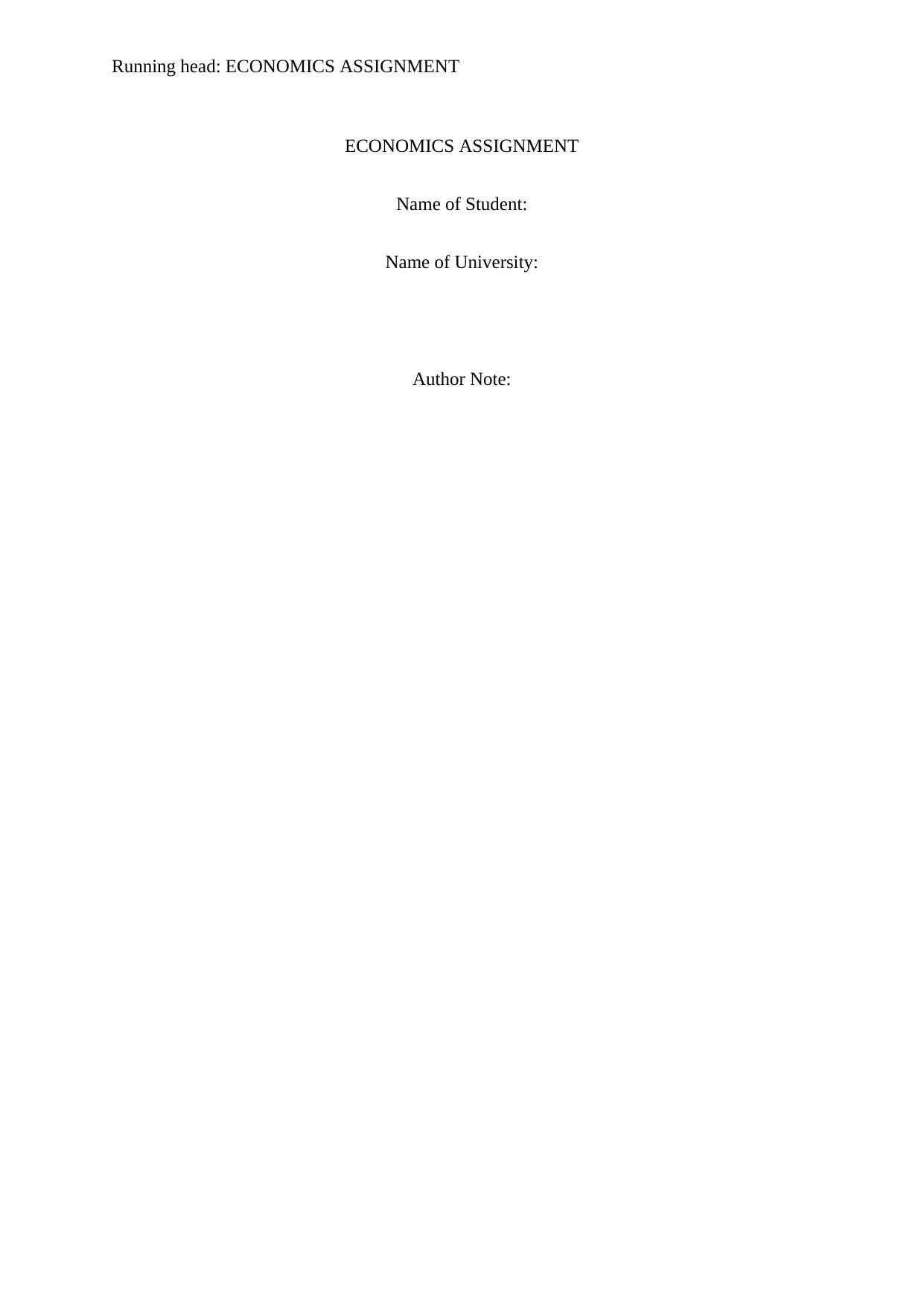
Running head: ECONOMICS ASSIGNMENT
ECONOMICS ASSIGNMENT
Name of Student:
Name of University:
Author Note:
ECONOMICS ASSIGNMENT
Name of Student:
Name of University:
Author Note:
Paraphrase This Document
Need a fresh take? Get an instant paraphrase of this document with our AI Paraphraser
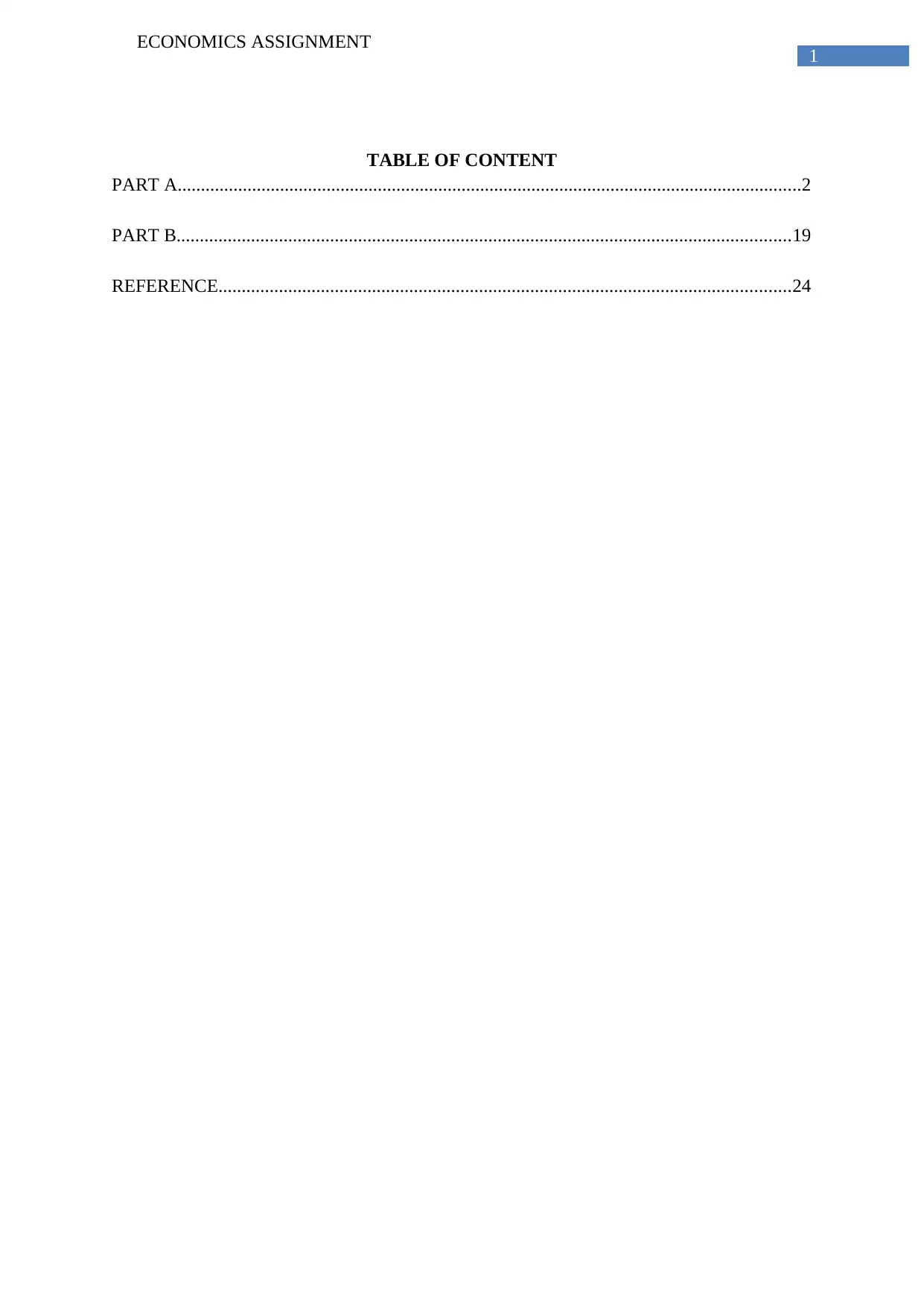
1
ECONOMICS ASSIGNMENT
TABLE OF CONTENT
PART A......................................................................................................................................2
PART B....................................................................................................................................19
REFERENCE...........................................................................................................................24
ECONOMICS ASSIGNMENT
TABLE OF CONTENT
PART A......................................................................................................................................2
PART B....................................................................................................................................19
REFERENCE...........................................................................................................................24
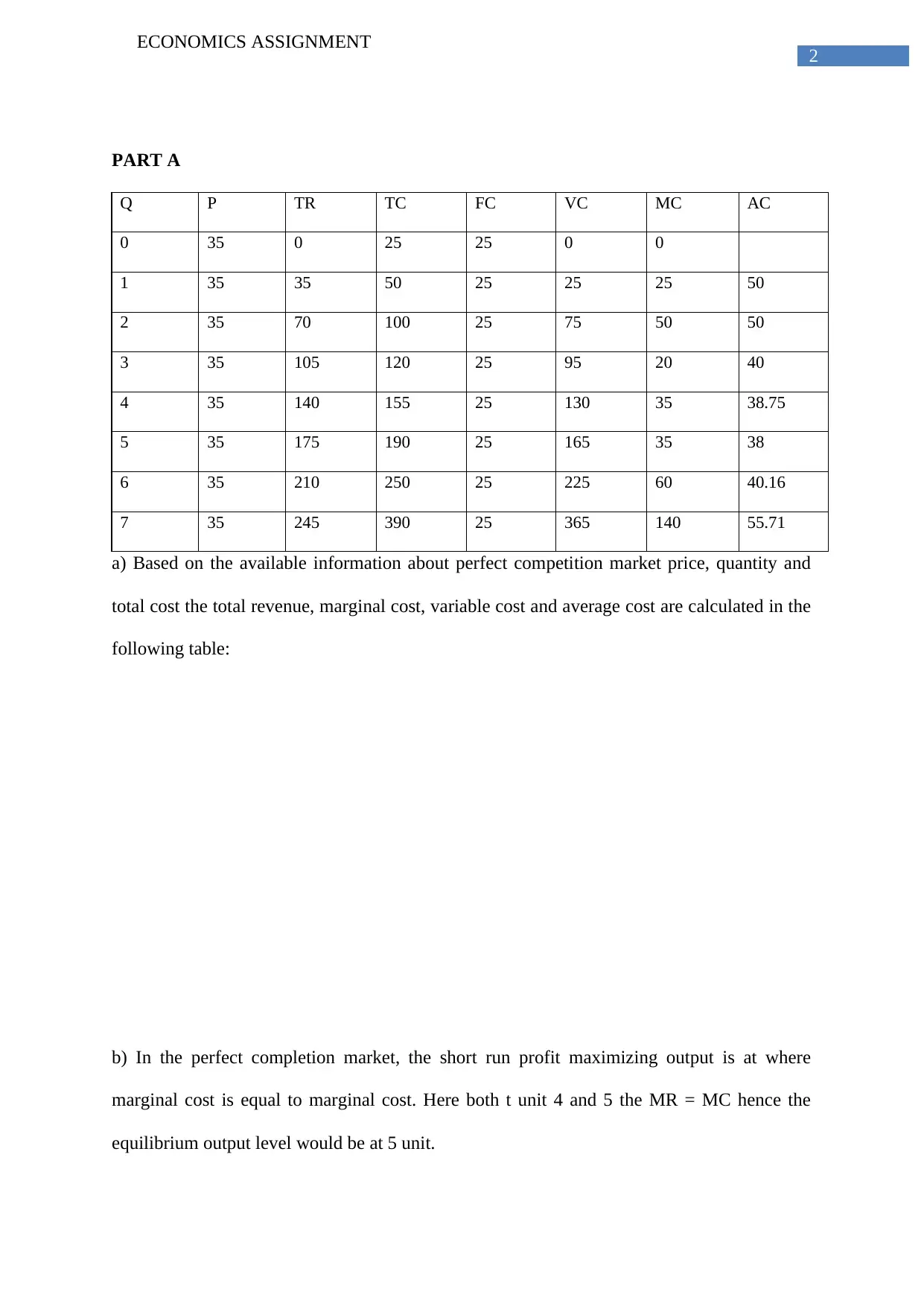
2
ECONOMICS ASSIGNMENT
PART A
Q P TR TC FC VC MC AC
0 35 0 25 25 0 0
1 35 35 50 25 25 25 50
2 35 70 100 25 75 50 50
3 35 105 120 25 95 20 40
4 35 140 155 25 130 35 38.75
5 35 175 190 25 165 35 38
6 35 210 250 25 225 60 40.16
7 35 245 390 25 365 140 55.71
a) Based on the available information about perfect competition market price, quantity and
total cost the total revenue, marginal cost, variable cost and average cost are calculated in the
following table:
b) In the perfect completion market, the short run profit maximizing output is at where
marginal cost is equal to marginal cost. Here both t unit 4 and 5 the MR = MC hence the
equilibrium output level would be at 5 unit.
ECONOMICS ASSIGNMENT
PART A
Q P TR TC FC VC MC AC
0 35 0 25 25 0 0
1 35 35 50 25 25 25 50
2 35 70 100 25 75 50 50
3 35 105 120 25 95 20 40
4 35 140 155 25 130 35 38.75
5 35 175 190 25 165 35 38
6 35 210 250 25 225 60 40.16
7 35 245 390 25 365 140 55.71
a) Based on the available information about perfect competition market price, quantity and
total cost the total revenue, marginal cost, variable cost and average cost are calculated in the
following table:
b) In the perfect completion market, the short run profit maximizing output is at where
marginal cost is equal to marginal cost. Here both t unit 4 and 5 the MR = MC hence the
equilibrium output level would be at 5 unit.
⊘ This is a preview!⊘
Do you want full access?
Subscribe today to unlock all pages.

Trusted by 1+ million students worldwide
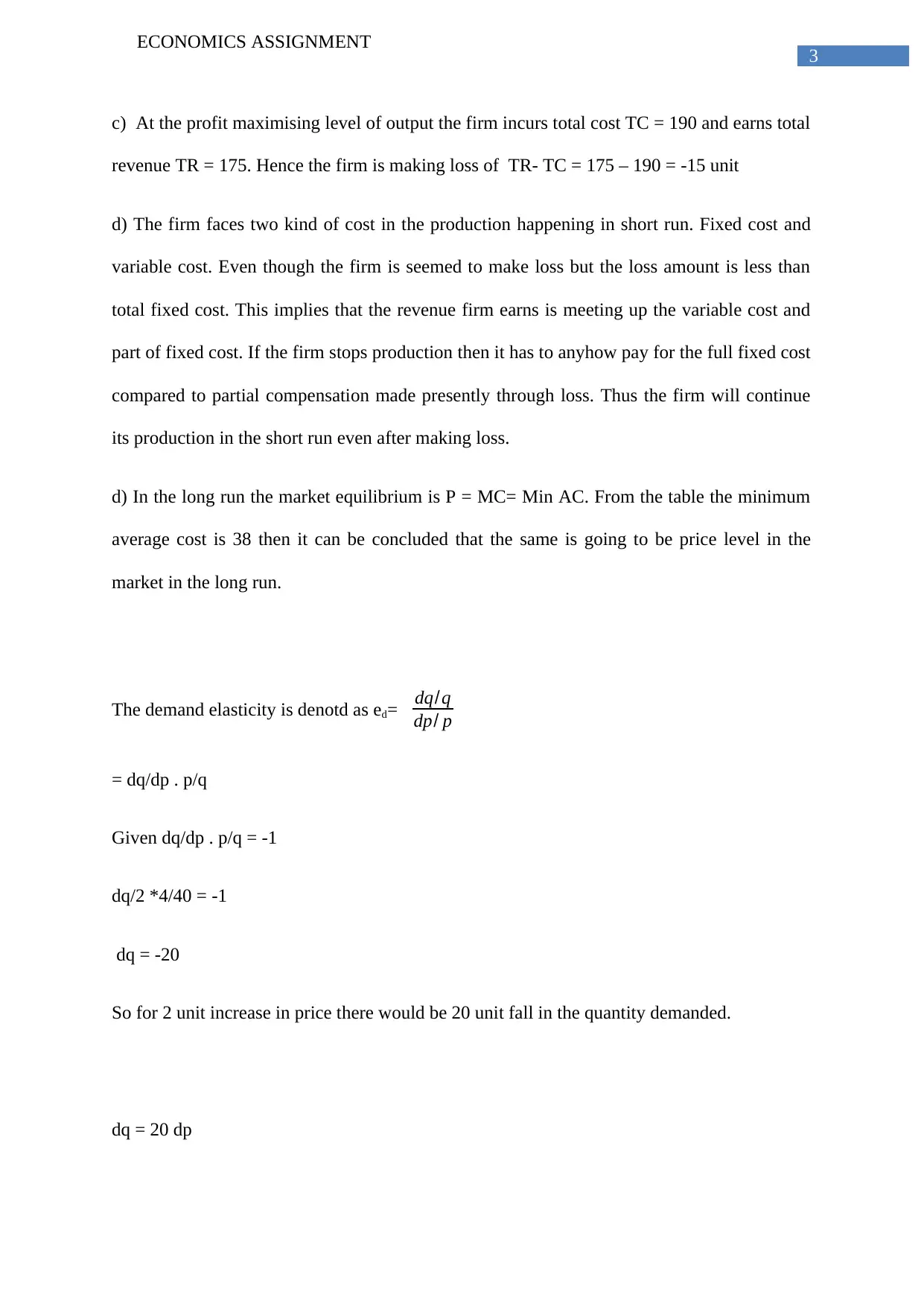
3
ECONOMICS ASSIGNMENT
c) At the profit maximising level of output the firm incurs total cost TC = 190 and earns total
revenue TR = 175. Hence the firm is making loss of TR- TC = 175 – 190 = -15 unit
d) The firm faces two kind of cost in the production happening in short run. Fixed cost and
variable cost. Even though the firm is seemed to make loss but the loss amount is less than
total fixed cost. This implies that the revenue firm earns is meeting up the variable cost and
part of fixed cost. If the firm stops production then it has to anyhow pay for the full fixed cost
compared to partial compensation made presently through loss. Thus the firm will continue
its production in the short run even after making loss.
d) In the long run the market equilibrium is P = MC= Min AC. From the table the minimum
average cost is 38 then it can be concluded that the same is going to be price level in the
market in the long run.
The demand elasticity is denotd as ed= dq/q
dp/ p
= dq/dp . p/q
Given dq/dp . p/q = -1
dq/2 *4/40 = -1
dq = -20
So for 2 unit increase in price there would be 20 unit fall in the quantity demanded.
dq = 20 dp
ECONOMICS ASSIGNMENT
c) At the profit maximising level of output the firm incurs total cost TC = 190 and earns total
revenue TR = 175. Hence the firm is making loss of TR- TC = 175 – 190 = -15 unit
d) The firm faces two kind of cost in the production happening in short run. Fixed cost and
variable cost. Even though the firm is seemed to make loss but the loss amount is less than
total fixed cost. This implies that the revenue firm earns is meeting up the variable cost and
part of fixed cost. If the firm stops production then it has to anyhow pay for the full fixed cost
compared to partial compensation made presently through loss. Thus the firm will continue
its production in the short run even after making loss.
d) In the long run the market equilibrium is P = MC= Min AC. From the table the minimum
average cost is 38 then it can be concluded that the same is going to be price level in the
market in the long run.
The demand elasticity is denotd as ed= dq/q
dp/ p
= dq/dp . p/q
Given dq/dp . p/q = -1
dq/2 *4/40 = -1
dq = -20
So for 2 unit increase in price there would be 20 unit fall in the quantity demanded.
dq = 20 dp
Paraphrase This Document
Need a fresh take? Get an instant paraphrase of this document with our AI Paraphraser
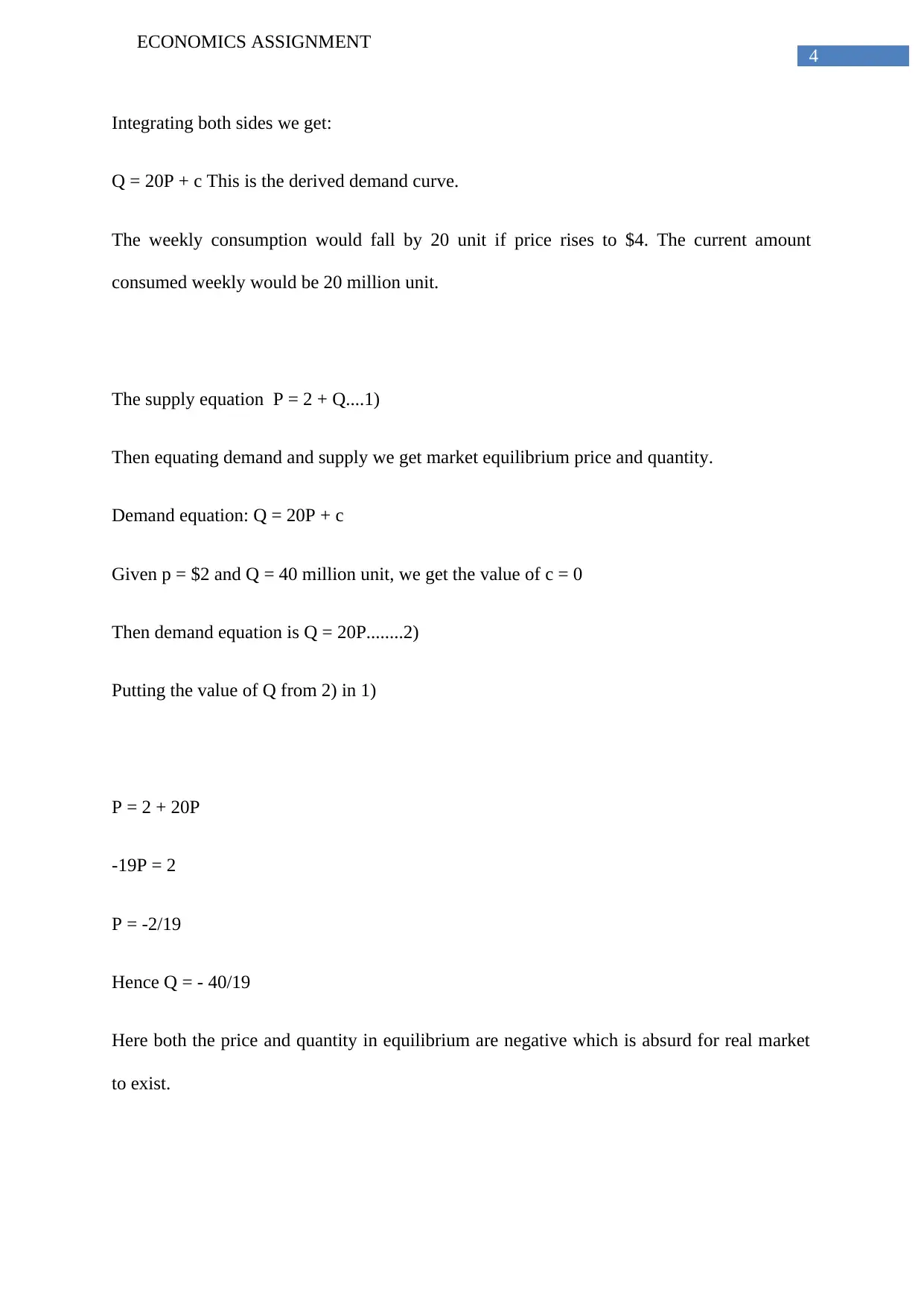
4
ECONOMICS ASSIGNMENT
Integrating both sides we get:
Q = 20P + c This is the derived demand curve.
The weekly consumption would fall by 20 unit if price rises to $4. The current amount
consumed weekly would be 20 million unit.
The supply equation P = 2 + Q....1)
Then equating demand and supply we get market equilibrium price and quantity.
Demand equation: Q = 20P + c
Given p = $2 and Q = 40 million unit, we get the value of c = 0
Then demand equation is Q = 20P........2)
Putting the value of Q from 2) in 1)
P = 2 + 20P
-19P = 2
P = -2/19
Hence Q = - 40/19
Here both the price and quantity in equilibrium are negative which is absurd for real market
to exist.
ECONOMICS ASSIGNMENT
Integrating both sides we get:
Q = 20P + c This is the derived demand curve.
The weekly consumption would fall by 20 unit if price rises to $4. The current amount
consumed weekly would be 20 million unit.
The supply equation P = 2 + Q....1)
Then equating demand and supply we get market equilibrium price and quantity.
Demand equation: Q = 20P + c
Given p = $2 and Q = 40 million unit, we get the value of c = 0
Then demand equation is Q = 20P........2)
Putting the value of Q from 2) in 1)
P = 2 + 20P
-19P = 2
P = -2/19
Hence Q = - 40/19
Here both the price and quantity in equilibrium are negative which is absurd for real market
to exist.
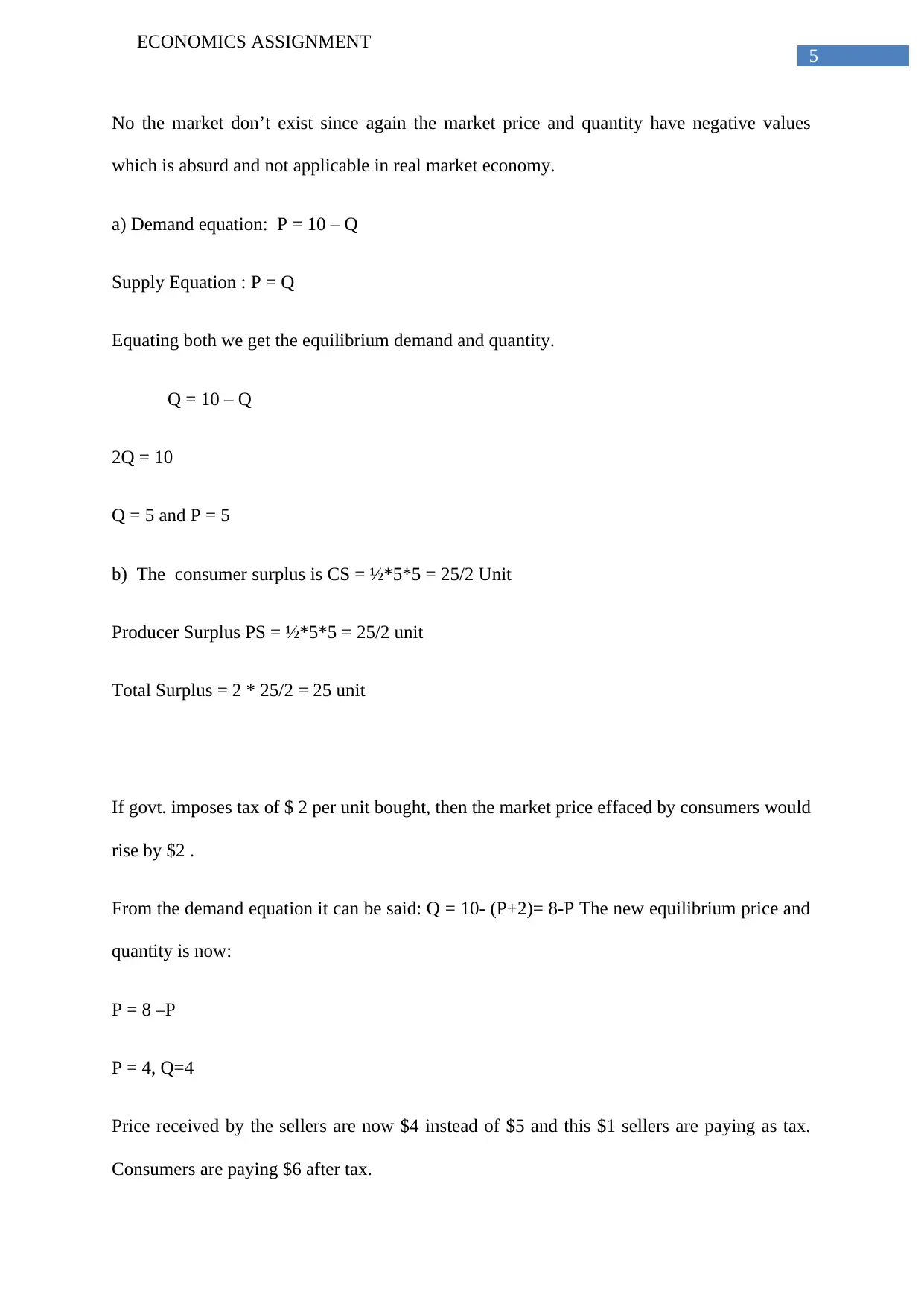
5
ECONOMICS ASSIGNMENT
No the market don’t exist since again the market price and quantity have negative values
which is absurd and not applicable in real market economy.
a) Demand equation: P = 10 – Q
Supply Equation : P = Q
Equating both we get the equilibrium demand and quantity.
Q = 10 – Q
2Q = 10
Q = 5 and P = 5
b) The consumer surplus is CS = ½*5*5 = 25/2 Unit
Producer Surplus PS = ½*5*5 = 25/2 unit
Total Surplus = 2 * 25/2 = 25 unit
If govt. imposes tax of $ 2 per unit bought, then the market price effaced by consumers would
rise by $2 .
From the demand equation it can be said: Q = 10- (P+2)= 8-P The new equilibrium price and
quantity is now:
P = 8 –P
P = 4, Q=4
Price received by the sellers are now $4 instead of $5 and this $1 sellers are paying as tax.
Consumers are paying $6 after tax.
ECONOMICS ASSIGNMENT
No the market don’t exist since again the market price and quantity have negative values
which is absurd and not applicable in real market economy.
a) Demand equation: P = 10 – Q
Supply Equation : P = Q
Equating both we get the equilibrium demand and quantity.
Q = 10 – Q
2Q = 10
Q = 5 and P = 5
b) The consumer surplus is CS = ½*5*5 = 25/2 Unit
Producer Surplus PS = ½*5*5 = 25/2 unit
Total Surplus = 2 * 25/2 = 25 unit
If govt. imposes tax of $ 2 per unit bought, then the market price effaced by consumers would
rise by $2 .
From the demand equation it can be said: Q = 10- (P+2)= 8-P The new equilibrium price and
quantity is now:
P = 8 –P
P = 4, Q=4
Price received by the sellers are now $4 instead of $5 and this $1 sellers are paying as tax.
Consumers are paying $6 after tax.
⊘ This is a preview!⊘
Do you want full access?
Subscribe today to unlock all pages.

Trusted by 1+ million students worldwide
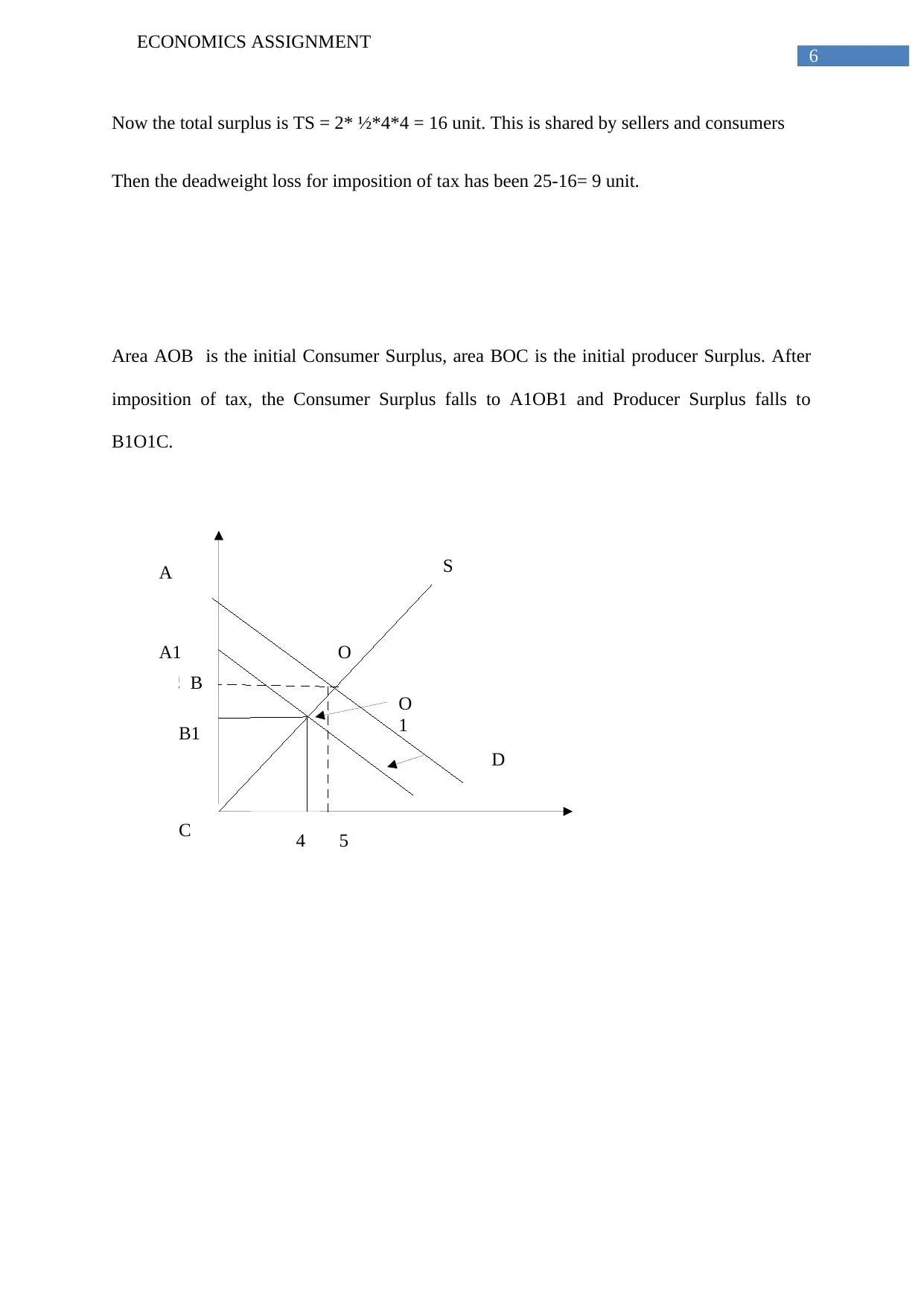
6
ECONOMICS ASSIGNMENT
D
S
5
54
A
O
B
C
A1
B1
O
1
Now the total surplus is TS = 2* ½*4*4 = 16 unit. This is shared by sellers and consumers
Then the deadweight loss for imposition of tax has been 25-16= 9 unit.
Area AOB is the initial Consumer Surplus, area BOC is the initial producer Surplus. After
imposition of tax, the Consumer Surplus falls to A1OB1 and Producer Surplus falls to
B1O1C.
ECONOMICS ASSIGNMENT
D
S
5
54
A
O
B
C
A1
B1
O
1
Now the total surplus is TS = 2* ½*4*4 = 16 unit. This is shared by sellers and consumers
Then the deadweight loss for imposition of tax has been 25-16= 9 unit.
Area AOB is the initial Consumer Surplus, area BOC is the initial producer Surplus. After
imposition of tax, the Consumer Surplus falls to A1OB1 and Producer Surplus falls to
B1O1C.
Paraphrase This Document
Need a fresh take? Get an instant paraphrase of this document with our AI Paraphraser
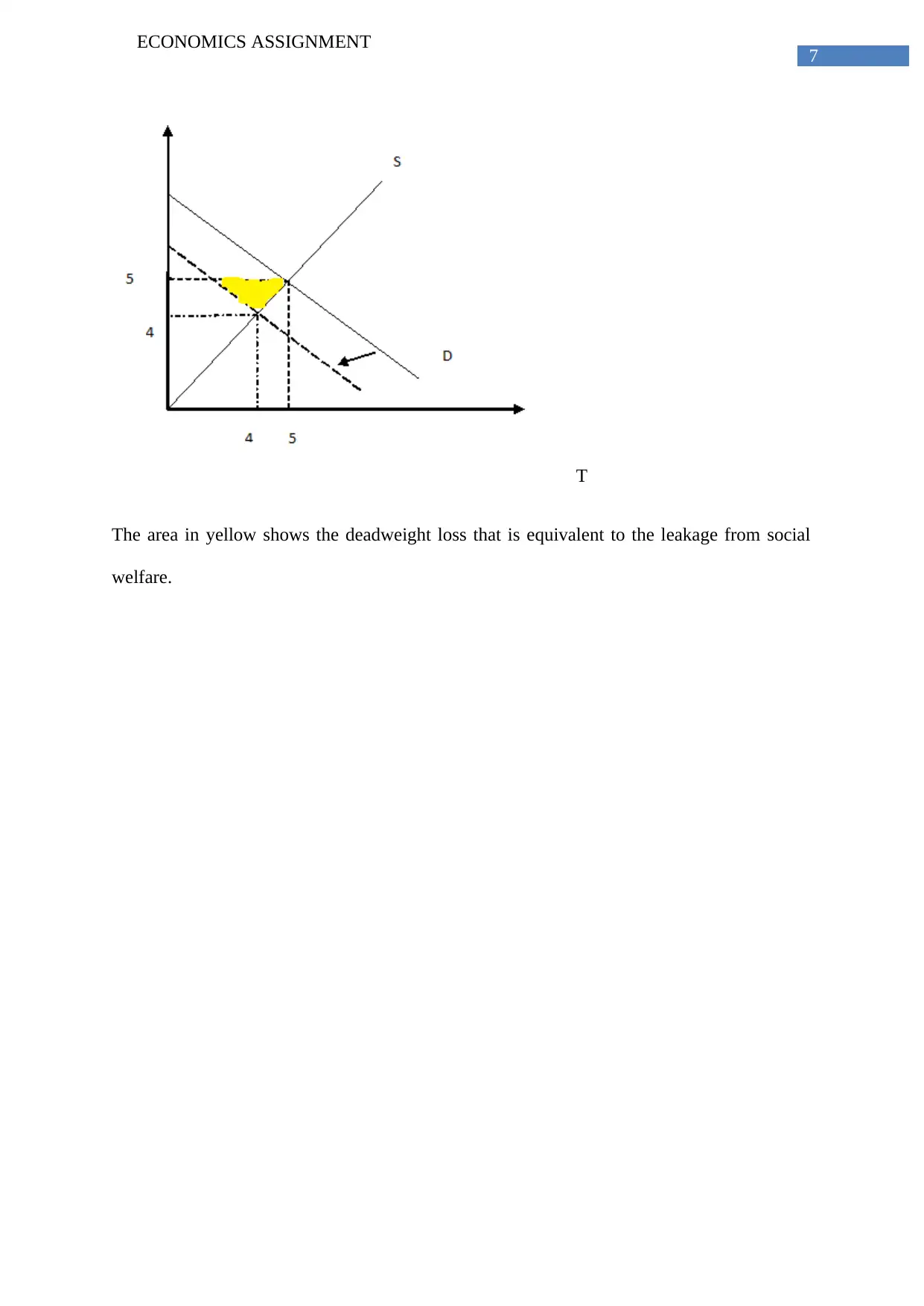
7
ECONOMICS ASSIGNMENT
T
The area in yellow shows the deadweight loss that is equivalent to the leakage from social
welfare.
ECONOMICS ASSIGNMENT
T
The area in yellow shows the deadweight loss that is equivalent to the leakage from social
welfare.
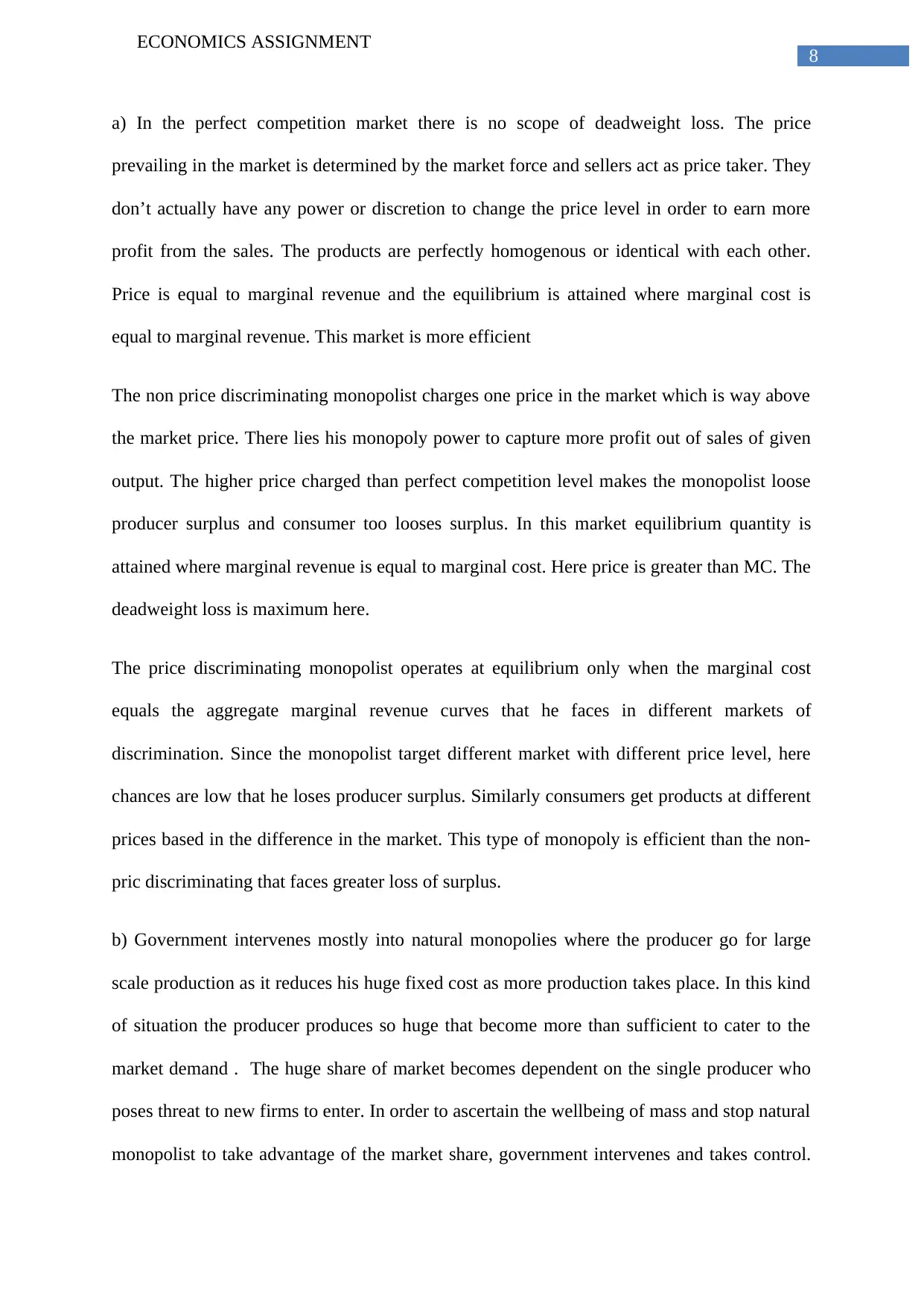
8
ECONOMICS ASSIGNMENT
a) In the perfect competition market there is no scope of deadweight loss. The price
prevailing in the market is determined by the market force and sellers act as price taker. They
don’t actually have any power or discretion to change the price level in order to earn more
profit from the sales. The products are perfectly homogenous or identical with each other.
Price is equal to marginal revenue and the equilibrium is attained where marginal cost is
equal to marginal revenue. This market is more efficient
The non price discriminating monopolist charges one price in the market which is way above
the market price. There lies his monopoly power to capture more profit out of sales of given
output. The higher price charged than perfect competition level makes the monopolist loose
producer surplus and consumer too looses surplus. In this market equilibrium quantity is
attained where marginal revenue is equal to marginal cost. Here price is greater than MC. The
deadweight loss is maximum here.
The price discriminating monopolist operates at equilibrium only when the marginal cost
equals the aggregate marginal revenue curves that he faces in different markets of
discrimination. Since the monopolist target different market with different price level, here
chances are low that he loses producer surplus. Similarly consumers get products at different
prices based in the difference in the market. This type of monopoly is efficient than the non-
pric discriminating that faces greater loss of surplus.
b) Government intervenes mostly into natural monopolies where the producer go for large
scale production as it reduces his huge fixed cost as more production takes place. In this kind
of situation the producer produces so huge that become more than sufficient to cater to the
market demand . The huge share of market becomes dependent on the single producer who
poses threat to new firms to enter. In order to ascertain the wellbeing of mass and stop natural
monopolist to take advantage of the market share, government intervenes and takes control.
ECONOMICS ASSIGNMENT
a) In the perfect competition market there is no scope of deadweight loss. The price
prevailing in the market is determined by the market force and sellers act as price taker. They
don’t actually have any power or discretion to change the price level in order to earn more
profit from the sales. The products are perfectly homogenous or identical with each other.
Price is equal to marginal revenue and the equilibrium is attained where marginal cost is
equal to marginal revenue. This market is more efficient
The non price discriminating monopolist charges one price in the market which is way above
the market price. There lies his monopoly power to capture more profit out of sales of given
output. The higher price charged than perfect competition level makes the monopolist loose
producer surplus and consumer too looses surplus. In this market equilibrium quantity is
attained where marginal revenue is equal to marginal cost. Here price is greater than MC. The
deadweight loss is maximum here.
The price discriminating monopolist operates at equilibrium only when the marginal cost
equals the aggregate marginal revenue curves that he faces in different markets of
discrimination. Since the monopolist target different market with different price level, here
chances are low that he loses producer surplus. Similarly consumers get products at different
prices based in the difference in the market. This type of monopoly is efficient than the non-
pric discriminating that faces greater loss of surplus.
b) Government intervenes mostly into natural monopolies where the producer go for large
scale production as it reduces his huge fixed cost as more production takes place. In this kind
of situation the producer produces so huge that become more than sufficient to cater to the
market demand . The huge share of market becomes dependent on the single producer who
poses threat to new firms to enter. In order to ascertain the wellbeing of mass and stop natural
monopolist to take advantage of the market share, government intervenes and takes control.
⊘ This is a preview!⊘
Do you want full access?
Subscribe today to unlock all pages.

Trusted by 1+ million students worldwide
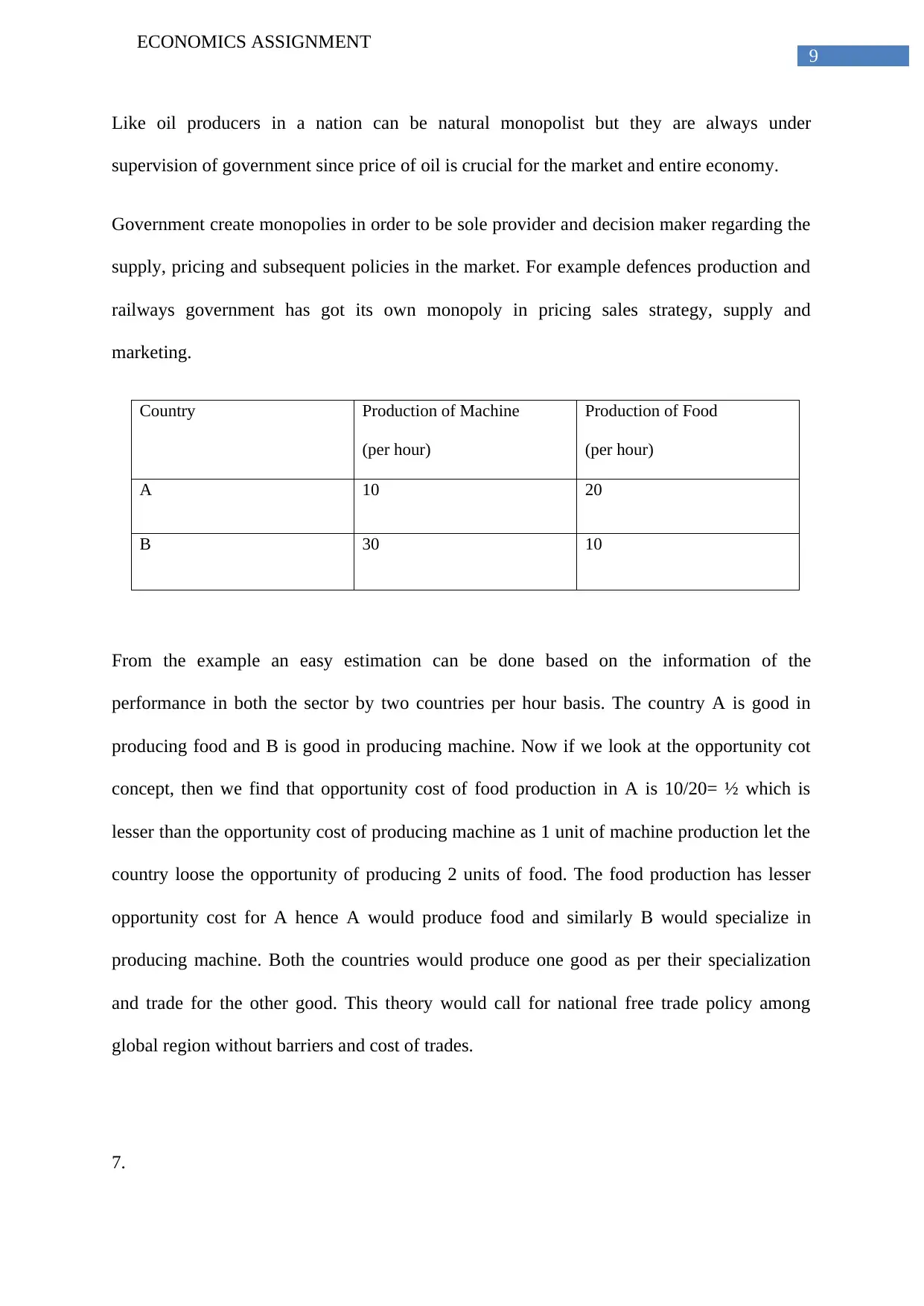
9
ECONOMICS ASSIGNMENT
Like oil producers in a nation can be natural monopolist but they are always under
supervision of government since price of oil is crucial for the market and entire economy.
Government create monopolies in order to be sole provider and decision maker regarding the
supply, pricing and subsequent policies in the market. For example defences production and
railways government has got its own monopoly in pricing sales strategy, supply and
marketing.
Country Production of Machine
(per hour)
Production of Food
(per hour)
A 10 20
B 30 10
From the example an easy estimation can be done based on the information of the
performance in both the sector by two countries per hour basis. The country A is good in
producing food and B is good in producing machine. Now if we look at the opportunity cot
concept, then we find that opportunity cost of food production in A is 10/20= ½ which is
lesser than the opportunity cost of producing machine as 1 unit of machine production let the
country loose the opportunity of producing 2 units of food. The food production has lesser
opportunity cost for A hence A would produce food and similarly B would specialize in
producing machine. Both the countries would produce one good as per their specialization
and trade for the other good. This theory would call for national free trade policy among
global region without barriers and cost of trades.
7.
ECONOMICS ASSIGNMENT
Like oil producers in a nation can be natural monopolist but they are always under
supervision of government since price of oil is crucial for the market and entire economy.
Government create monopolies in order to be sole provider and decision maker regarding the
supply, pricing and subsequent policies in the market. For example defences production and
railways government has got its own monopoly in pricing sales strategy, supply and
marketing.
Country Production of Machine
(per hour)
Production of Food
(per hour)
A 10 20
B 30 10
From the example an easy estimation can be done based on the information of the
performance in both the sector by two countries per hour basis. The country A is good in
producing food and B is good in producing machine. Now if we look at the opportunity cot
concept, then we find that opportunity cost of food production in A is 10/20= ½ which is
lesser than the opportunity cost of producing machine as 1 unit of machine production let the
country loose the opportunity of producing 2 units of food. The food production has lesser
opportunity cost for A hence A would produce food and similarly B would specialize in
producing machine. Both the countries would produce one good as per their specialization
and trade for the other good. This theory would call for national free trade policy among
global region without barriers and cost of trades.
7.
Paraphrase This Document
Need a fresh take? Get an instant paraphrase of this document with our AI Paraphraser
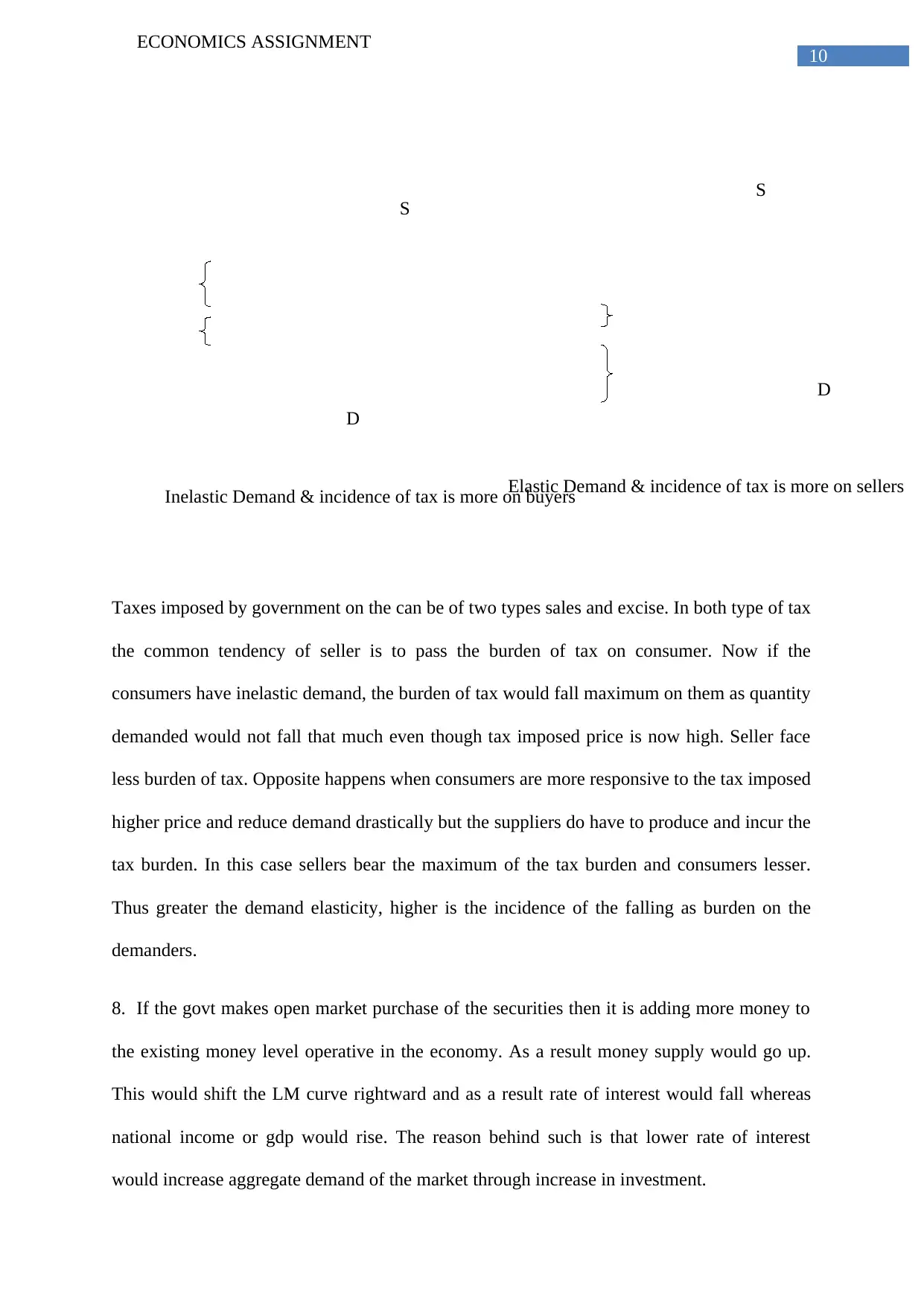
10
ECONOMICS ASSIGNMENT
D
S
D
S
Inelastic Demand & incidence of tax is more on buyers
Elastic Demand & incidence of tax is more on sellers
Taxes imposed by government on the can be of two types sales and excise. In both type of tax
the common tendency of seller is to pass the burden of tax on consumer. Now if the
consumers have inelastic demand, the burden of tax would fall maximum on them as quantity
demanded would not fall that much even though tax imposed price is now high. Seller face
less burden of tax. Opposite happens when consumers are more responsive to the tax imposed
higher price and reduce demand drastically but the suppliers do have to produce and incur the
tax burden. In this case sellers bear the maximum of the tax burden and consumers lesser.
Thus greater the demand elasticity, higher is the incidence of the falling as burden on the
demanders.
8. If the govt makes open market purchase of the securities then it is adding more money to
the existing money level operative in the economy. As a result money supply would go up.
This would shift the LM curve rightward and as a result rate of interest would fall whereas
national income or gdp would rise. The reason behind such is that lower rate of interest
would increase aggregate demand of the market through increase in investment.
ECONOMICS ASSIGNMENT
D
S
D
S
Inelastic Demand & incidence of tax is more on buyers
Elastic Demand & incidence of tax is more on sellers
Taxes imposed by government on the can be of two types sales and excise. In both type of tax
the common tendency of seller is to pass the burden of tax on consumer. Now if the
consumers have inelastic demand, the burden of tax would fall maximum on them as quantity
demanded would not fall that much even though tax imposed price is now high. Seller face
less burden of tax. Opposite happens when consumers are more responsive to the tax imposed
higher price and reduce demand drastically but the suppliers do have to produce and incur the
tax burden. In this case sellers bear the maximum of the tax burden and consumers lesser.
Thus greater the demand elasticity, higher is the incidence of the falling as burden on the
demanders.
8. If the govt makes open market purchase of the securities then it is adding more money to
the existing money level operative in the economy. As a result money supply would go up.
This would shift the LM curve rightward and as a result rate of interest would fall whereas
national income or gdp would rise. The reason behind such is that lower rate of interest
would increase aggregate demand of the market through increase in investment.
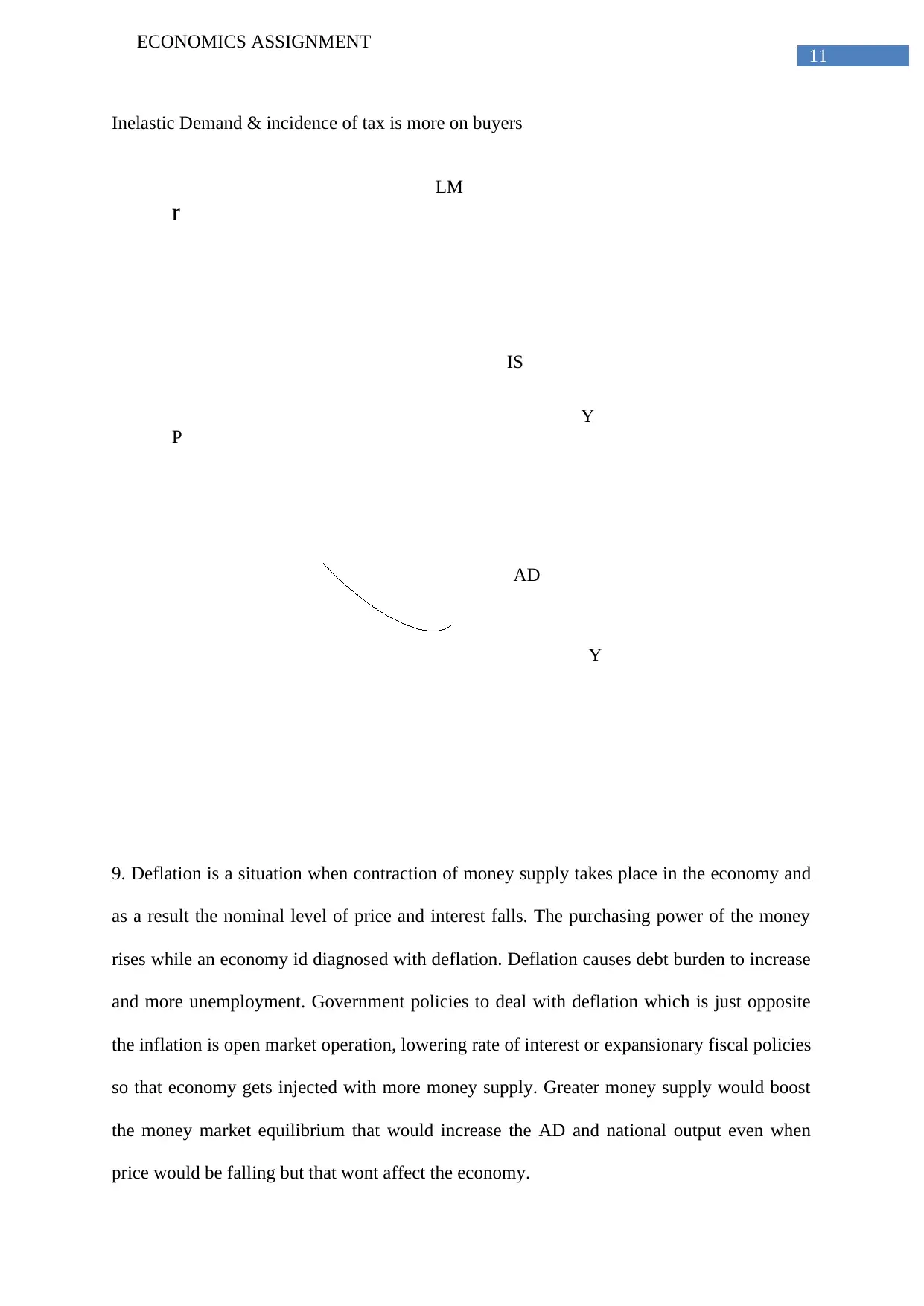
11
ECONOMICS ASSIGNMENT
r
Y
LM
IS
AD
Y
P
Inelastic Demand & incidence of tax is more on buyers
9. Deflation is a situation when contraction of money supply takes place in the economy and
as a result the nominal level of price and interest falls. The purchasing power of the money
rises while an economy id diagnosed with deflation. Deflation causes debt burden to increase
and more unemployment. Government policies to deal with deflation which is just opposite
the inflation is open market operation, lowering rate of interest or expansionary fiscal policies
so that economy gets injected with more money supply. Greater money supply would boost
the money market equilibrium that would increase the AD and national output even when
price would be falling but that wont affect the economy.
ECONOMICS ASSIGNMENT
r
Y
LM
IS
AD
Y
P
Inelastic Demand & incidence of tax is more on buyers
9. Deflation is a situation when contraction of money supply takes place in the economy and
as a result the nominal level of price and interest falls. The purchasing power of the money
rises while an economy id diagnosed with deflation. Deflation causes debt burden to increase
and more unemployment. Government policies to deal with deflation which is just opposite
the inflation is open market operation, lowering rate of interest or expansionary fiscal policies
so that economy gets injected with more money supply. Greater money supply would boost
the money market equilibrium that would increase the AD and national output even when
price would be falling but that wont affect the economy.
⊘ This is a preview!⊘
Do you want full access?
Subscribe today to unlock all pages.

Trusted by 1+ million students worldwide
1 out of 28
Related Documents
Your All-in-One AI-Powered Toolkit for Academic Success.
+13062052269
info@desklib.com
Available 24*7 on WhatsApp / Email
![[object Object]](/_next/static/media/star-bottom.7253800d.svg)
Unlock your academic potential
Copyright © 2020–2025 A2Z Services. All Rights Reserved. Developed and managed by ZUCOL.





